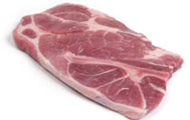USMEF: Strong expansion in pork muscle cuts

Both U.S. beef and pork exports grew in February, with strong expansion in muscle cuts leading the way in both, according to statistics released by the USDA and compiled by the U.S. Meat Export Federation (USMEF).
The monthly value of total U.S. beef exports (muscle cuts and variety meat) jumped 14.5 percent compared to one year ago to reach $252.5 million, while tonnage climbed 8.6 percent to 71,843 metric tons (158.4 million pounds).
©
Pork exports for the month moved up slightly over one year ago, increasing 2.6 percent in value to $377.6 million and just under 1 percent in volume to 159,331 metric tons (351.3 million pounds).
©
“There are solid signs of progress in key markets,” said Philip Seng, USMEF president and CEO. “And that means positive growth in profitability for U.S. producers.”
©
Pork exports in February accounted for 25 percent of total U.S. pork production, equating to nearly $44 per head, up from $37.37 per head just last month. On the beef side, exports remained steady at 10 percent of production but the value edged up to $123 per head of steer and heifer slaughter from $119 in January.
©
Pork export growth to Mexico continues
Mexico emerged as a solid No. 1 destination for U.S. pork in 2009, and that growth continues in 2010 with a 9 percent hike in volume to 99,768 metric tons (219.9 million pounds) in January and February valued at $173 million – a 24 percent jump.
©
“Pork exports to Mexico helped contribute to the high ham values and high pork cutout values in the first two months of the year,” noted Daley. “In January-February, the pork cutout averaged more than $70/cwt, which was about 24 percent higher than last year.”
©
Domestic pork production in Japan continues to rise, affecting imports. According to data by Japan’s Agriculture and Livestock Industries Corporation (ALIC), domestic pork production has increased year-on-year each month since March 2009. Marketing of domestic pork in Japan’s current fiscal year (data available for April 2009 through January 2010) is up 7 percent while marketing of imported pork is down nearly 14 percent.
©
U.S.©pork muscle cut exports to Japan recovered in February, up 21 percent from January but still off 8.5 percent from last year. For the first two months of 2010, exports were down 17 percent at 59,896 metric tons (132 million pounds) valued at $233.5 million, a decrease of 15 percent. The U.S. continues to dominate in the high-value chilled pork market, earning a 73 percent market share – down only 1 percent from last year. Canada and Denmark each gained mainly in frozen market share as the overall U.S. share of total imports slipped from 48 percent last year to 43 percent.
©
Several other export markets helped the U.S. maintain pork export levels in the first two months of 2010:
- Canada©– exports were up 7 percent in volume to 24,535 metric tons (54.1 million pounds) and 17 percent in value to $84.3 million.
© - China/Hong Kong – this region purchased 15 percent more muscle cuts in the two-month span compared to a year ago, totaling 20,591 metric tons (45.4 million pounds) valued at $34 million, an increase of 32 percent. Hong Kong accounted for 100 percent of the shipments due mainly to the continued H1N1-related Chinese market closure. February exports totaled 14,535 metric tons (32 million pounds) – the largest monthly volume of pork muscle cut exports to the region since July 2007. China/Hong Kong also was the No. 2 export market for U.S. pork variety meat behind Mexico, with exports up 14 percent to 25,658 metric tons (56.6 million pounds) valued at $34.4 million, down 4 percent from last year.
© - The ASEAN region – muscle cut exports were double year-ago levels (up 111 percent) to 11,247 metric tons (24.8 million pounds) valued at $22.3 million, an increase of 102 percent. Exports to the Philippines jumped 117 percent to 8,877 metric tons (19.6 million pounds).
© - South Korea©– the impact of the Chile-Korea Free Trade Agreement has been felt this year, with two-month muscle cut U.S. exports dipping 37 percent to 10,815 metric tons (23.8 million pounds) valued at $23.6 million, a decrease of 41 percent. According to Korean import data, the decline is much smaller, with imports from the U.S. down 8 percent in the first two months of 2010 while imports from all suppliers were up 4 percent, due mainly to a 65 percent increase in imports from Chile. “Through the Chile-Korea FTA, Chile benefits from duties of less than 10 percent compared to 22 percent to 25 percent (depending on the product) paid by the U.S.,” said Daley. “The KORUS FTA would help put the U.S. on track with Chile.”
© - Oceania©– pork muscle cut exports to this region increased 7 percent to 9,031 metric tons (19.9 million pounds) valued at $19.5 million, which is even with last year. Exports to Australia were up 13 percent to 8,469 metric tons (18.7 million pounds).
© - Russia©– pork muscle cuts were down 85 percent to 1,663 metric tons (3.7 million pounds) as the new export protocols were not brought online until March.











